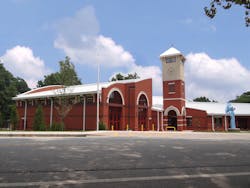Fire Station Planning: The Good and Bad Decisions
Capt. William A. Pearson, Jr., City of Atlanta Fire Rescue Department, is a good resource for all-things related to building fire stations. As the department’s Construction Project Manager, Pearson has teamed with the Office of Enterprise and Asset Management (OEAM) and the project management department for the fire department on the last three fire facility projects: construction of Station 28; designing and remodeling Station 7; and currently working on the design and soon to come, construction of Station 22.
We asked Capt. Pearson to share some of his thoughts on good decisions and some bad decisions that he has made over the years.
Among the decisions Pearson is glad they made, he offered:
- Designing a community/training room into the station—Pearson explained, “The community room brings the community and the department together. It also allows the station and the battalion to use the room for training purposes. It is a requirement that the room be able to hold a minimum of 52 people seated. This way we know the room can house an entire battalion in case the battalion chief needs to have a battalion meeting or training session.”
- Having dye integrated into the concrete before pouring—“This allowed for the concrete to be stained/dyed throughout. Having concrete stained after the pour leads to wear marks and if something is dropped and chips the concrete, you would get a noticeable discoloration in that area because the concrete was not dyed throughout,” said Pearson.
- Conducting a turn-radius test on our apparatus when turning out of the station—An apparatus is supposed to be able to turn onto the street without impeding the opposite lane or interfering with oncoming traffic heading from the opposite direction. Pearson said, “With Station 28 coming on board, I was promoted to my position after the drawings were done. I played a part in the construction of the station. Once in my position, I had the opportunity to look at the drawings prior to the constructing of the building. I noticed there was almost a 45-degree turn going north off of the apron and onto the public street. I found out there was not a turn-radius test performed to determine if our largest piece of apparatus (tiller and truck) would be able to make the turn without impeding oncoming traffic. I was able to get the necessary information from our fleet department, which showed the turning radius for each apparatus. It was determined neither tiller nor truck would be able to make the turn without impeding traffic. Because of this, we had to concrete a large amount of an area that was designated for grass, which allowed for a more reasonable turn.”
- In addition, have a drive test done of the apron once poured—Pearson added, “Due to having to shift Station 28 75 feet to the north because of a major miss by the architect, no one took into consideration how it would affect the slope of the driveway/apron. Before the apron was poured, knowing my apparatus, I was concerned about the slope of the apron. I informed the engineers and OEAM of my concerns and was told it would be ok. After the slope was poured, I immediately asked for a drive test because I knew my apparatus would bottom out at the beginning of the slope and at the top where the apron meets the public road. My assumptions were correct and there had to be some modifications done to the apron.”
- Adding through-wall lockers in each bunk—“With having individual bunks, these lockers allow for access by the members to the lockers from within the bunkroom as well as from outside of the bunkroom,” said Pearson. “This keeps individuals from disturbing other firefighters who may be still asleep during shift change.”
No project is with ever completed without some regrets or wishes for a “do-over.” One decision that was out of Pearson’s hands, but he wishes had a different outcome was the decision to retain a fire station because it was the oldest station in Atlanta. Although not on the historical list, the building is currently under renovation.
“With no historical value other than the shell of the building, there was no true reason to keep it,” said Pearson. “A new station would have allowed the city to have a station that fit the city and the departments’ initiatives. We would have been able to take advantage of other items and assets that would have made for a more sustainable, soundproof and stable facility.”
Pearson also regrets not including training props into the design of their newest station.
“Implementing training props would have allowed our department to have its first sub-training station,” he said. “This would have kept us from adversely affecting our training academy due to the amount of recruit classes we currently have and will have in the future, as well as our training academy being given the status of a regional training facility. Regional status would allow our academy the ability to teach the same classes as our state training academy and allow for outside departments to come and train at our academy.”
JANET WILMOTH grew up in a family of firefighters in a suburb of Chicago. Wilmoth, owner of Wilmoth Associates, worked with Fire Chief magazine for 27 years until it closed in 2013. She is currently a Project Director for Firehouse. Wilmoth currently serves on the Board of Directors for the Fire Emergency Manufacturers & Services Association and lives in Lisle, IL.
